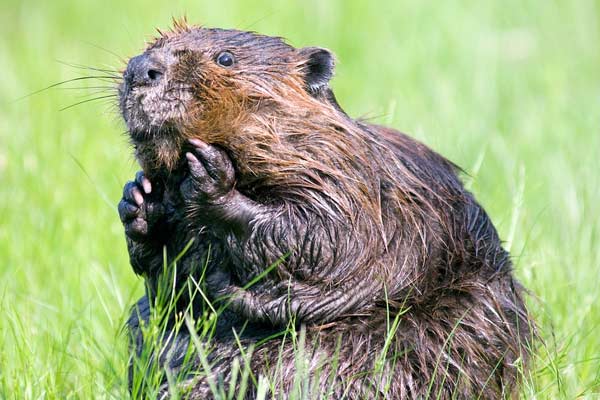Why The Beaver Represents Everything Canadian
Although not as magnificent as the American bald eagle or as endearing as China’s Giant Panda, one thing is certain: Canada’s national animal, the North American Beaver, embodies all that is distinctively Canadian.
If we base our facts solely on historical significance, the cod may rival the beaver. However, there’s more to the beaver than just its historical significance in establishing modern Canada.
Even without its fur coat, the beaver exhibits several characteristics that are distinctively Canadian in its own right. Here are some reasons why the beaver is the ideal Canadian animal.
1. Beavers are traditional Canadians
Beavers are highly industrious, stay with the same spouse their whole lives, and usually only have one family every year.
And they bear no resemblance to the promiscuous, baby-making rodents to which they are sometimes likened. The Norwegian rat, for example, begins reproducing two months after birth and produces litters of six to 22 offspring three to twelve times each year.
The North American Beaver, on the other hand, likes to wait. Although they achieve sexual maturity at one year of age, most do not mate until they are 2 – 3 years old, and they usually have two to four kits.
2. They had a significant impact on Canada’s growth
Beaver pelts were essential to the Canadian fur trade, with Aboriginal and European hunters supplying trade networks with beaver pelts, which were mostly used to produce top hats, which were popular in Europe throughout the 18th and 19th centuries.
As the beaver became rare in certain areas, the network spread, laying the framework for Canada’s growth.
Surprisingly, demand for beaver pelts persisted long into the twentieth century. Trappers sold a record number of beaver pelts in 1981.
3. They are quite adaptable to their surroundings
Canadians live in a variety of habitats, including Arctic ice, coastal rainforest, sprawling metropolitan landscapes, and skyscraping mountains. No matter what the environment throws at them, they can adapt.
Don’t be fooled by their round appearance. Beavers have some amazing adaptations; they have been known to use their incisor teeth and strong lower jaw muscles to fell trees up to a meter in diameter.
Beavers can chop and chew wood when immersed in water because of their protruding incisors, which keep their mouths shut. In addition, they don’t have to hurry down there. Beavers have a 15-minute underwater endurance limit.
They are good swimmers because of their broad flat tail that serves as a rudder and their webbed feats. A protective translucent membrane enables them to keep their eyes open when submerged, while valves in their ears and nostrils prevent water from entering their bodies.
It is possible for them to pull construction materials and food through the water because their lips are closed behind their front teeth, preventing them from drowning. And, perhaps most impressively, the enamel of beavers’ teeth contains iron, which makes their teeth very robust and capable of felling trees.
4. They’re Beneficial to the environment
Beavers are a keystone species because they help maintain wetlands environments, which are vital to the survival of many other species.
They also aid in the mitigation of floods and droughts. According to research conducted by the University of Alberta, removing the beaver from the wetlands constituted an “environmental disturbance.”
“They may be one of the most effective approaches to reducing wetland loss in drought times,” lead author Glynnis Hood said of his results.
“While some people assume that climate is the driving force behind everything, the presence of beavers has a significant impact on the availability of open water in a given location. Beavers are assisting in preserving water in regions that would otherwise be dry.”
There have been reports of beavers diverting a whole stream in the early 1900s.
5. Beavers are both aggressive and welcoming creatures
With the longest undefended border in the world, a recent history of being open and hospitable to refugees and immigrants, as well as a worldwide reputation for being courteous, Canada is a desirable destination for many people.
Beavers, on the other hand, are equally concerned about their fellow beavers (as well as any other creatures within hearing distance) and will warn them of imminent danger with a watery slap of their tail. Beavers are herbivores, which means they do not prey on other animals.
It also helps that they are hospitable: they often share their lodges with muskrats and have even been seen on video grooming their visitors. Don’t underestimate them though; beavers may be aggressive, and their teeth can inflict painful bites.
6. Indigenous peoples saw them as essential
The beaver played an essential role in the lives of indigenous peoples, who exploited the animal for their benefit. Beaver meat, which has three times as many calories as other red meats, was a staple of Native American diets during the winter months in addition to fur.
Their teeth were also utilized as chisels and ornate necklaces by Native American societies.
There was a common thread of reverence for the beaver, despite the widespread practice of hunting it, throughout the indigenous peoples.
7. Beavers have ingenious methods to survive the cold
To get through the winter, Canadians have ice hotels, Carnaval, skating, and ice fishing. Beavers use lodges to stay warm in the winter. Beaver colonies build dams to provide deep, calm water to construct a lodge—a very amazing building of trees, rocks, and mud.
The lodge is safe and toasty since the entrances are below sea level. And, much as Canadians take out their comforters, thick drapes, and toasty pajamas for the winter months, beavers warm up their lodge with a beautiful coating of mud on top.
8. They like constructing large structures
The longest beaver lodge ever found is 850 meters long and is situated in Wood Buffalo National Park in Alberta. Experts believe it has been built by numerous generations of beavers since the 1970s.
Canadians also like to construct enormous structures, such as the CN Tower, the world’s biggest free-standing building, until 2010, when the Burj Khalifa skyscraper surpassed it in Abu Dhabi and the Guangzhou Tower in Guangzhou.
Canadians also have a fondness for somewhat odder huge things, most notably a slew of massive roadside attractions strewn over the country.
From the world’s biggest potato on Prince Edward Island to the world’s largest hockey stick in Duncan, BC, Canada’s terrain is peppered with massive landmarks, including a gigantic beaver in Beaverlodge, Alberta.








